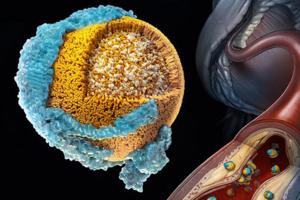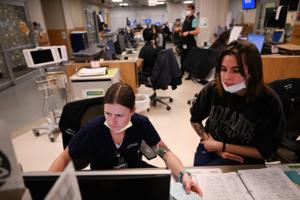Health Advice
/Health

Minnesota city awarded $1 million state grant for planned pig-to-human transplant center
MINNEAPOLIS — The state Department of Employment and Economic Development has awarded a southeastern Minnesota city a $1 million grant to support the state’s first pig-to-human transplant center.
Stewartville will use the funding, announced Monday, to construct streets and public utilities around the Schumann Business Park, the future home ...Read more

Norovirus cases spike, CDC says. What to know about the highly contagious stomach bug
Certain areas of the United States are seeing spikes in cases of norovirus, a highly contagious stomach bug, health experts said.
The Centers for Disease Control and Prevention reported 91 outbreaks of norovirus during the week of Dec. 5, up 32% from the last week of November and the highest recorded number of outbreaks for this time period in ...Read more

Florida was to expand children's health insurance. Instead, it's been kicking kids off its rolls
ORLANDO, Fla. — During the COVID-19 pandemic, Erin Booth’s 5-year-old son was diagnosed with leukemia. She and her husband qualified for Medicaid under a program enacted during the health crisis and that federal insurance provided Landon all the medical treatment and therapy he needed.
The chemotherapy damaged Landon’s still-developing ...Read more

Can probiotic supplements prevent hangovers?
The ads on podcasts and social media were tantalizing: over-the-counter probiotic supplements that could ward off the worst effects of a hangover if taken before drinking.
As a bourbon reviewer who enjoys the flavor of spirits but has always been easily prone to hangovers, Eric Burke was intrigued. He ordered a few bottles of Pre-Alcohol, a ...Read more

Baltimore buildings reopen after Legionella mitigation
BALTIMORE — Three municipal buildings in downtown Baltimore reopened for full service Monday after elevated levels of Legionella bacteria were detected in the water supply.
The city said in a Monday morning news release that it conducted flushing and chlorination treatments as well as other mitigation efforts over the weekend at City Hall, ...Read more

8 ways couples can make resolutions that boost health and relationships
You're ready to ring in the new year with your special someone. Does that mean you're ready to make healthy resolutions together, too?
Focusing on health together is a good idea, but it can be tricky, experts say.
"Spouses or partners have powerful influences on one another's physical activity, dietary behavior and sleep in particular," said ...Read more

Why one Colorado county -- alone among large communities -- has seen a steady drop in its suicide rate over five years
DENVER -- Over the last five years, Larimer County in northern Colorado has seen what appears to be a steady, sustained drop in its suicide rate — a potentially significant breakthrough in a state that consistently ranks in the top 10 nationally for its high rate.
How the county got there was a decade-long affair in which local officials, ...Read more

Infectious disease doctor talks about telePrEP and the future of HIV care
PHILADELPHIA — The Immunodeficiency Center at Jefferson Einstein Philadelphia Hospital opened in 1994 with 40 patients unable to get care from other doctors who were wary of treating HIV patients or didn't know how to provide the specialized care they needed.
Thirty years later, the center has expanded beyond HIV care to provide psychiatric, ...Read more

Eating disorders are the most lethal mental health conditions – reconnecting with internal body sensations can help reduce self-harm
Did you know that anorexia is the most lethal mental health condition? One person dies from an eating disorder every hour in the U.S. Many of these deaths are not from health consequences related to starvation, but from suicide.
Up to 1 in 5 women and 1 in 7 men in the U.S. will develop an eating disorder by age 40, and 1 in 2 people ...Read more

How are states spending opioid settlement cash? KFF Health News is tracking
In the past few years, state and local governments across the U.S. have begun spending billions in opioid settlements paid by companies accused of fueling the overdose crisis. But where is that money going, who is getting it, and is it doing any good?
KFF Health News, partnering with the Johns Hopkins Bloomberg School of Public Health and ...Read more

How a duty to spend wisely on worker benefits could loosen PBMs' grip on drug prices
Ann Lewandowski knows all about pharmacy benefit managers, or PBMs, the companies that shape the U.S. drug market. Her job, as a policy advocate at drugmaker Johnson & Johnson, was to tell patient and physician groups about the PBMs’ role in high drug prices.
Armed with that knowledge, Lewandowski filed a potentially groundbreaking lawsuit in...Read more

Breakthrough technology sees how cholesterol causes heart attacks
ATLANTA — The U.S. government’s premier research body has made an important discovery that could help create new drugs to lower “bad” cholesterol, and hopefully prevent heart attacks and stroke.
But the interesting part of that story isn’t just the discovery itself, but the technology responsible for it: a relatively new type of ...Read more

Baltimore circuit courts reopen after Legionella remediation, retesting
BALTIMORE — The Baltimore City circuit courthouses and the District Court on East Fayette Street reopened Thursday after being treated for Legionella bacteria earlier this week.
Legionella is the bacteria which can cause Legionnaire’s disease, a severe form of pneumonia. The city recommended the courthouses close last week despite the ...Read more

Posting hospital prices hasn't brought down the cost of health care. Will Colorado's new approach work?
When the idea of price transparency first took hold outside purely academic circles, the pitch was simple: Coloradans would save themselves and the system money by shopping for health care the way they do for TVs or cars.
But shopping for health care has proven more difficult than buying consumer goods. A poll released in August found about 69%...Read more

Bill of the Month: He went in for a colonoscopy. The hospital charged $19,000 for two
Tom Contos is an avid runner. When he started experiencing rectal bleeding in March, he thought exercise could be the cause and tried to ignore it. But he became increasingly worried when the bleeding continued for weeks.
The Chicago health care consultant contacted his physician at Northwestern Medicine, who referred him for a diagnostic ...Read more

Ask the Pediatrician: 8 parenting goals to start the new year strong
New Year's resolutions are typically sweeping and grand. But you can often reap the biggest rewards by building off strengths already in place. Helping to make your family safer, stronger and more harmonious in the coming year may not require a complete overhaul, but rather a few strategic tweaks.
The start of a new year is a great time to take...Read more

What if you could rank food by ‘healthiness’ as you shopped? Nutrient profiling systems use algorithms to simplify picking healthy groceries
Imagine a world where food on grocery store shelves is ranked by its healthiness, with simple, research-backed scores. In some countries, that world already exists.
Nutrient profiling systems, or NPSs, support clear front-of-package labels that assess food quality based on nutrient content. Nutri-Score in France is a rainbow-colored ...Read more

UW plans to launch mental health crisis response team this spring
SEATTLE — Starting this spring, the University of Washington will try a new approach to helping students and employees in mental health crises, based on a philosophy that's become increasingly mainstream: Mental health professionals are better equipped than police to respond to some emergencies.
In emergencies that don't involve a safety risk...Read more

Could a maverick raw milk farmer from California help RFK Jr. shape US health policy?
As Mark McAfee — the maverick leader of California’s largest raw milk dairy — works on getting his Fresno County dairy out of bird flu quarantine, his name has surfaced as a possible advisor for the Food and Drug Administration on shaping raw milk policy in the United States.
The founder of Raw Farm credits a celebrity customer, Robert F....Read more
Ebola: how a vaccine turned a terrifying virus into a preventable disease
The Ebola virus devastated west Africa in 2014, claiming over 11,000 lives in Sierra Leone, Liberia and Guinea.
It was the largest Ebola outbreak since the virus had first been discovered in the Democratic Republic of Congo in 1976.
Ebola is a terrifying virus which, if left untreated, causes bleeding inside the body and ...Read more
Popular Stories
- Bill of the Month: He went in for a colonoscopy. The hospital charged $19,000 for two
- Infectious disease doctor talks about telePrEP and the future of HIV care
- 8 ways couples can make resolutions that boost health and relationships
- How are states spending opioid settlement cash? KFF Health News is tracking
- Can probiotic supplements prevent hangovers?








